Question
Question: A parallel plate capacitor has area of each plate A, the separation between the plates d. It is char...
A parallel plate capacitor has area of each plate A, the separation between the plates d. It is charged to a potential V and then disconnected from the battery. How much work will be done in filling the capacitor completely with a dielectric of constant K?

21dϵ0AV2(1−K21)
21KdV2ϵ0A
21K2dV2ϵ0A
21dϵ0AV2(1−K1)
(4)
Solution
The problem asks for the work done in filling a parallel plate capacitor with a dielectric after it has been charged and disconnected from the battery. When the capacitor is disconnected from the battery, the charge on its plates remains constant.
1. Initial State (before filling with dielectric):
- Area of each plate = A
- Separation between plates = d
- Initial capacitance, C0=dϵ0A
- The capacitor is charged to a potential V. So, the initial potential difference across the plates is V0=V.
- The charge stored on the plates, Q=C0V0=dϵ0AV.
- The initial energy stored in the capacitor, U0=21C0V02=21(dϵ0A)V2.
2. After Disconnection from Battery:
- Once disconnected, the charge Q on the plates remains constant.
3. Final State (after filling completely with dielectric):
- The dielectric constant of the material is K.
- The new capacitance, Cf=KC0=Kdϵ0A.
- Since the charge Q is constant, the new potential difference across the plates will be Vf=CfQ. Substituting Q=C0V0 and Cf=KC0: Vf=KC0C0V0=KV0=KV.
- The final energy stored in the capacitor can be calculated using the constant charge Q: Uf=21CfQ2=21KC0Q2. We know U0=21C0Q2. Therefore, Uf=KU0. Substituting the expression for U0: Uf=K1(21dϵ0AV2)=21Kdϵ0AV2.
4. Work Done:
When a dielectric is inserted into a capacitor with constant charge, the energy stored in the capacitor decreases (Uf<U0 since K>1). This decrease in energy is released as work done by the electric field on the dielectric, pulling it into the capacitor. The work done in filling the capacitor is the energy released, which is the difference between the initial and final stored energies: Work Done (W) = U0−Uf W=21dϵ0AV2−21Kdϵ0AV2 Factor out the common term: W=21dϵ0AV2(1−K1)
The calculated work done matches option (4).
